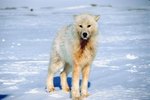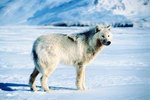
Mountain lions live in every climate in the New World, from the frozen North to the frigid South and the steamy tropics in between. They really like cool upland areas, but as long as their kind of food is available, they seem able to adapt to almost any weather.
North
The furthest north the mountain lion goes is the Canadian Yukon, which has an arctic or subarctic tundra climate featuring long, cold winters with short days and short summers with long, warm days. Rumors and reports of lions there have been circulating for about 100 years, but the first documented presence of the species was in 2000, when a partially frozen cougar was found in 17-degree weather, living in an abandoned car and eating nobody knows what. Normally, the lions don't mind the cold -- they just put on their undercoat -- and the summer warmth doesn't last long enough to be a problem for them.
South
Passing through the Amazon rainforest and the pampas of Argentina, in Patagonia, at the far end of South America, the puma finds the tundra again at the opposite extreme of his range. The cool climate of the high, dry uplands of the Andes suits these cats perfectly, and the abundant guanaco is his favorite prey.
East
The temperate climate of the eastern half of the U.S., with the geographic features of low mountains and hills and extensive forests, is prime cougar habitat, but the cats themselves are scarce on the ground. It can't be a lack of prey, because there is currently a glut of whitetail deer, especially in suburban yards and gardens. The eastern cougar has been declared extinct by the U.S. Fish & Wildlife Service, but locals continue to report sightings and one occasionally turns up as roadkill. USFWS officials consider these to be transients, young males looking for a home range. The sole surviving known breeding population of cougars is in Florida, where the cats are known as panthers or painters. This once-doomed subspecies, Puma concolor coryi, seems to tolerate Florida's warm, humid climate well, but habitat loss and inbreeding reduced their numbers to less than 30 until some Texas cougars were imported to expand the gene pool; the Florida population is now on the upswing at more than 100.
West
The western half of the U.S. is the mountain lion's stronghold. They thrive in the misty temperate timberlands of Washington and Oregon, throughout the warmer climates of California and all the way down to the deserts of Baja California. Arizona's cool mountains and scalding deserts are all lion habitat. All the western states have good cougar populations, but in spite of similar climates, the further east one travels, the scarcer pumas become, probably due to higher human populations. That said, if you live in a rural, suburban and even fringe urban area where there are deer or feral hogs, chances are one or more of the estimated 35,000 cougars in the continental 48 states may be sharing your climate and watching you, whether you know it or not.
References
- The Cougar Fund: The Range of the American Cougar
- Internet Center for Wildlife Damage Management: Mountain Lions
- Sierra Club: Mountain Lion, Puma concolor
- Open Space: Mountain Lions
- What's the Weather Like: The Climate of Patagonia (Argentina)
- Scientific American: How to Restore the Florida Panther: Add a Little Texas Cougar
Resources
- Our Amazing Planet: Condors Drive Cougars to Kill More
- Agriculture in the Classroom, Saskatchewan: Yukon
- Arizona Game and Fish Department: Frequently Asked Questions about Mountain Lions
- NBC News.com: Cougars Extinct in East? No Way, Say Those Who Claim Sightings
- Florida Panther: Florida Panther Facts
- Mountain Lion Foundation: Answers to Your Questions about Mountain Lions
Photo Credits
-
Jupiterimages/Photos.com/Getty Images




